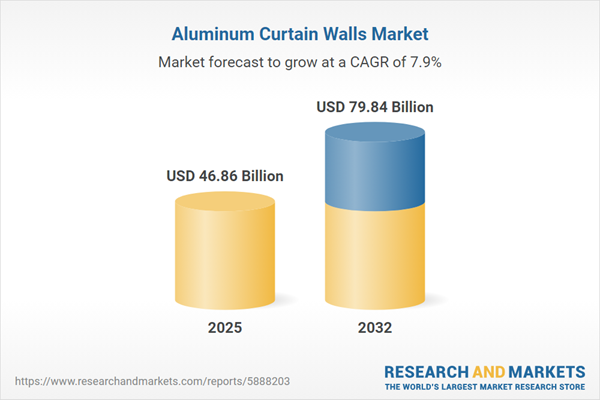Speak directly to the analyst to clarify any post sales queries you may have.
The aluminum curtain walls market is evolving to meet the needs of modern construction by offering sustainable, adaptable, and high-performance façade systems for commercial and institutional applications. This is shaping procurement and project planning strategies for senior decision-makers seeking value-driven outcomes in building projects.
Market Snapshot: Growth Trajectory in the Aluminum Curtain Walls Market
The aluminum curtain walls market is witnessing consistent growth, with projections indicating a rise from USD 43.38 billion in 2024 to USD 46.86 billion in 2025 and a further increase to USD 79.84 billion by 2032, signifying a compound annual growth rate (CAGR) of 7.92%.
This trajectory reflects sustained investment from construction and real estate sectors, fueled by the increasing adoption of energy-efficient façade systems. Factors contributing to this expansion include technological advancements in façade solutions, rising emphasis on sustainable urban development, and an evolving regulatory landscape. As project portfolios expand, aluminum curtain walls continue to gain relevance in both new builds and retrofit projects, highlighting their role in modern building strategies.Scope & Segmentation of the Aluminum Curtain Walls Market
This report examines the key elements influencing the aluminum curtain walls market, providing in-depth segmentation to help senior leaders steer procurement and project strategy effectively:
- System Types: Semi-unitized, stick, and unitized systems suited to diverse needs for modularity and project delivery speed.
- Glazing Types: Double, single, and triple glazing to address varying demands for thermal regulation and noise control.
- Applications: Solutions span commercial, industrial, and residential deployments, each governed by distinct functional and compliance requirements.
- End Users: Sectors such as healthcare, hospitality, real estate (office and residential), and retail prioritize advanced façades for occupant well-being and productivity.
- Installation Types: Options for new construction and retrofits support asset lifecycle extension and value preservation.
- Regions: Global coverage includes the Americas, Europe, Middle East, Africa, and Asia-Pacific; the methodology enables detailed country-level review, with focused analysis on areas like China for local regulatory nuances.
- Key Companies: Leading participants include Kawneer Company, Inc., Norsk Hydro ASA, Schüco International KG, Saint-Gobain S.A., Permasteelisa Group S.p.A., Oldcastle BuildingEnvelope, Inc., EFCO Corporation, and Dongwha Enterprise Co., Ltd., each offering distinctive regional presence and technology portfolios.
- Technological Features: Adoption of thermal breaks, automated shading, digital design tools, and modular processes enhances efficiency and facilitates scale across various project types.
This segmentation enables organizations to align their operational objectives with market developments, local code requirements, and technology advancements.
Key Takeaways for Decision-Makers
- Sustainability is integral to supplier selection, with growing demand for low-carbon alloys and resource-efficient supply models in major projects.
- Flexible façade and glazing technologies empower firms to meet regulatory, occupant comfort, and performance needs across diverse usage scenarios.
- The use of digital tools such as Building Information Modeling and parametric design solutions is streamlining processes, supporting accuracy, and fostering interdisciplinary collaboration.
- Regulatory changes, including those related to energy efficiency and seismic standards, are redefining specification and compliance expectations, opening new possibilities and responsibilities.
- Research-driven innovations in coatings and sensor integration facilitate predictive maintenance and enhance monitoring for improved asset management.
Progress in material choices and process optimization supports timely delivery and strengthens organizations’ capacity to thrive under future industry conditions.
Tariff Impact on Market Dynamics
Recent U.S. tariffs on aluminum have changed how industry participants approach sourcing for curtain wall systems. With higher input costs, companies are increasingly considering local and regional alternatives, leading to shifts in procurement and manufacturing strategies that enhance supply chain resilience and product consistency. Suppliers are responding by adopting transparent supply chain systems, incorporating blockchain and advanced risk management to address evolving customer and regulatory expectations.
Methodology & Data Sources
The findings in this analysis stem from a structured research method that blends comprehensive secondary data review with direct industry expert feedback. The approach uses quantitative modeling, triangulation, and scenario forecasting to validate and ensure the accuracy of market insights.
Why This Report Matters
- Empowers senior executives with actionable intelligence on drivers and technology trends to support sound investments and strategic planning.
- Equips teams to manage complex operational and regulatory landscapes using focused, reliable market analysis.
- Explains how digitalization and sustainability trends impact competitive advantage in building and construction.
Conclusion
Transformation across technology, regulation, and application is defining new directions for the aluminum curtain wall market. Stakeholders who adapt and innovate will position themselves to address evolving demands and leverage opportunities in the built environment.
Additional Product Information:
- Purchase of this report includes 1 year online access with quarterly updates.
- This report can be updated on request. Please contact our Customer Experience team using the Ask a Question widget on our website.
Table of Contents
3. Executive Summary
4. Market Overview
7. Cumulative Impact of Artificial Intelligence 2025
Samples

LOADING...
Companies Mentioned
The key companies profiled in this Aluminum Curtain Walls market report include:- Kawneer Company, Inc.
- Norsk Hydro ASA
- Schüco International KG
- Saint-Gobain S.A.
- Permasteelisa Group S.p.A.
- Oldcastle BuildingEnvelope, Inc.
- EFCO Corporation
- Dongwha Enterprise Co., Ltd.
Table Information
| Report Attribute | Details |
|---|---|
| No. of Pages | 187 |
| Published | October 2025 |
| Forecast Period | 2025 - 2032 |
| Estimated Market Value ( USD | $ 46.86 Billion |
| Forecasted Market Value ( USD | $ 79.84 Billion |
| Compound Annual Growth Rate | 7.9% |
| Regions Covered | Global |
| No. of Companies Mentioned | 9 |









